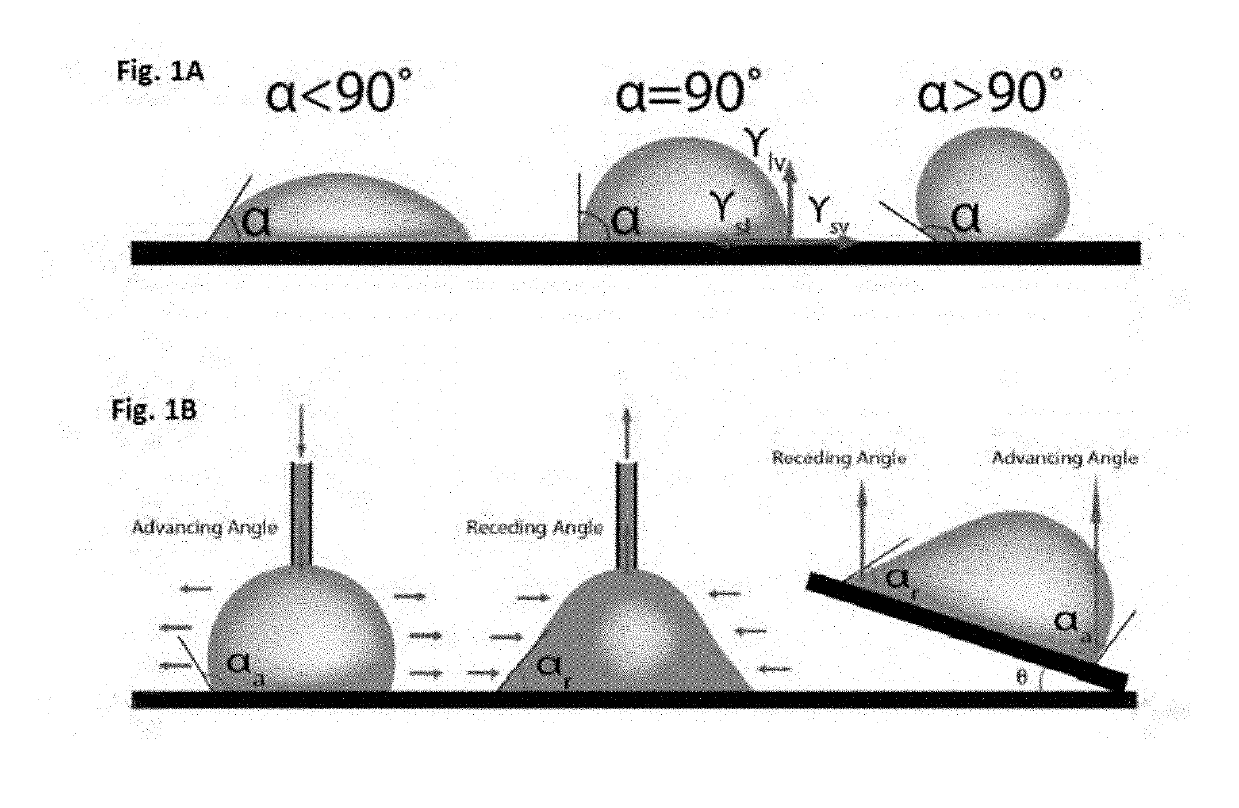Substrate with a superhydrophobic coating and a method of fabricating thereof
a superhydrophobic coating and substrate technology, applied in the direction of coatings, photovoltaic energy generation, photovoltaic cells, etc., can solve the problems of complex process, difficult to maintain solar cells to provide such efficiencies over an extended period of time, and high cos
- Summary
- Abstract
- Description
- Claims
- Application Information
AI Technical Summary
Benefits of technology
Problems solved by technology
Method used
Image
Examples
example 1
and Fabrication of Superhydrophobic Surfaces
[0188]The materials used to fabricate the intended robust superhydophobic and self-cleaning surfaces are: 1) Silicon dioxide (nanopowder, 10-20 nm particle size (BET), 99.5% trace metals basis), 2) Methyltrimethoxysilane (MTMS), (3-Glycidyloxypropyl) trimethoxysilane (GLYMO), 1,1,2,2-Perfluorooctyl-trichlorosilane (PFOTS), 3) ethanol, 4) acetone, 5) Ammonia (30 Vol %). All of these chemicals were purchased from Sigma-Aldrich, Germany. FIG. 5 shows the molecular structure of the MTMS, GLYMO and PFOTS used in our experiments. The deionized (DI) water used during the experiment was collected from the Milli-DI® Water Purification System.
[0189]The coatings are prepared by the sol-gel method. Accordingly, coating solution A (referred to as Sol A) is prepared by adding the following chemicals into the beaker during magnetic stirring at a constant speed throughout the synthesis process. Molar ratio of GLYMO: MTMS: DI=1:2:9 adopted which is corresp...
example 2
ization
[0199]A contact angle goniometer (Kyowa Interface, Inc. Japan) was used to determine the static water contact angle, sliding angle, advancing and receding contact angle, as shown in FIGS. 1(a) and 1(b). The hysteresis was calculated according to equation (I). The sessile drop model was used with the tangential method to measure the static water contact angles in a proper manner. Approximately 10 μl water droplets were carefully placed on the surface and the angle was measured from the captured image. Measurements, from different locations on the surface, were repeated at least 5 times for each sample to obtain an average value that was representative for the sample.
[0200]UV-VIS spectrophotometer (JASCO, V-670) was used to measure the transmittance of the spray coated glass slides in the visible light wavelength range of 400 to 780 nm as shown in FIG. 10. Transmittance of the surface to visible light is important for the fabricated surface since the intended use is mainly for ...
example 3
ting Parameters
[0216]For a uniform deposition of the coating solution on the glass surface, it is important to control the spray coating parameters within specific limits. Since transmittance of the glass substrate after the application of coating is important, each coating layer should be applied such that the decrease in transmittance is minimized. As mentioned, spray gun distances (10 and 15 cm) and five cycles (layers) were considered. FIGS. 15(a) and 15(b) show how each of the cycles (coating layers) of solution A affects the glass transmittance for both distances. Spraying of Sol A was performed immediately after 1 hour of stirring, otherwise Sol A viscosity increased and it transformed to gel with time as sol-gel reaction is taking place. As indicated in the FIGS. 15(a) and 15(b), transmittance of coated glass with sol A (Sol A was sprayed after 24 hours after sol A prepared). It is obvious that the coating reduces the transmittance and the thicker the coating the lower the t...
PUM
| Property | Measurement | Unit |
|---|---|---|
| Temperature | aaaaa | aaaaa |
| Temperature | aaaaa | aaaaa |
| Temperature | aaaaa | aaaaa |
Abstract
Description
Claims
Application Information
 Login to View More
Login to View More - R&D
- Intellectual Property
- Life Sciences
- Materials
- Tech Scout
- Unparalleled Data Quality
- Higher Quality Content
- 60% Fewer Hallucinations
Browse by: Latest US Patents, China's latest patents, Technical Efficacy Thesaurus, Application Domain, Technology Topic, Popular Technical Reports.
© 2025 PatSnap. All rights reserved.Legal|Privacy policy|Modern Slavery Act Transparency Statement|Sitemap|About US| Contact US: help@patsnap.com



